The best tourist attractions in Romania (for each county)
Discover Romania
When it comes to Romania tourism, some destinations are legendary. Bran Castle, widely popularised by Bram Stoker's "Dracula" as Dracula's Castle, is a must-see. But Romania boasts a wealth of other treasures: Peles Castle, the dramatic Corvin Castle, the unique Wooden Churches of Maramureș and the vibrantly painted Painted Churches of Bucovina. Mediaeval towns like Sibiu and Sighisoara transport you back in time.
If your Romania travel plans extend beyond a day trip, you'll be rewarded for exploring further. Romania offers breathtaking scenic drives like Transfăgărășan Road and Transalpina. Discover historic gems like Rasnov Fortress, the majestic Alba-Carolina Fortress in Alba Iulia, and the unique Turda Salt Mine. In Bucharest, the colossal Palace of Parliament stands as a testament to a bygone era. Immerse yourself in the charm of rural life at Viscri Village, a UNESCO World Heritage Site with a beautiful white fortified church. This is just a taste of the many Romania tourist places waiting to be discovered!
For more practical information about Romania's tourism, check our Romania Travel Guide.
1. Alba - Alba Carolina Fortress
For your Romania travel itinerary, consider the impressive Alba Carolina Citadel in Alba Iulia. Built between 1715 and 1738, it's Romania's largest fortress. Imagine a heptagon-shaped giant with 12 kilometres of walls, guarded by bastions at each corner! Delve deeper and discover its fascinating history – a Roman fort, a mediaeval stronghold, and ultimately a Vauban-style marvel. Since 2009, the daily Change of Guards ceremony (increasing to twice daily during weekends in peak season) has become a cherished symbol of the city, not to be missed on your Romania tourism adventure!

Aerial view of Alba Carolina Citadel, photo by viziteazaalbaiulia.ro
2. Arad - The Administrative Palace
The Palace is home to the Arad City Hall, and it is one of the most significant works of eclectic architecture in the city. The central tower of the building measures 54 metres in height, and at the top, it houses a clock with a bell. Don't miss this architectural wonder during your Romania tourism visit!
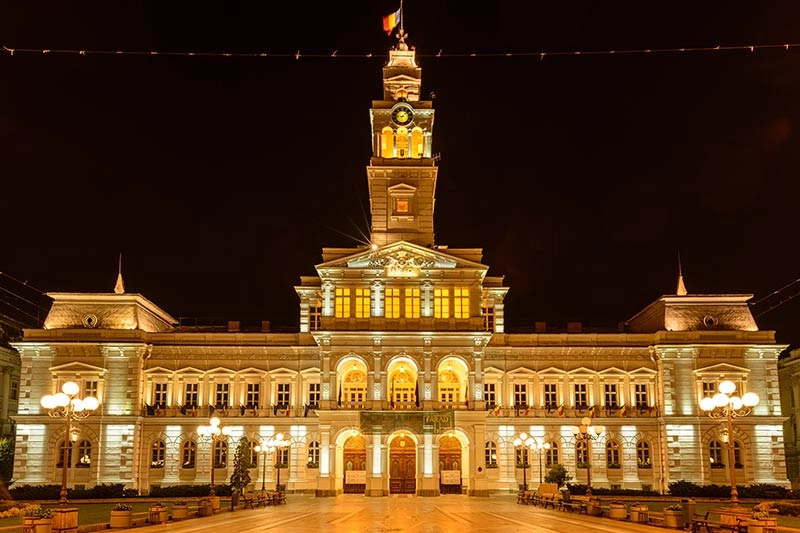
Arad Administrative Palace
3. Argeș - Curtea de Argeș Cathedral
Steeped in history and legend, Curtea de Argeș is a must-visit on your Romania tourism itinerary. Curtea de Argeș served as the first capital of Wallachia, and the construction of its cathedral gave birth to one of the most famous legends in Romania, the legend of Manole.

Curtea de Arges Monastery
The cathedral was built between 1512 and 1517, but two fires partly destroyed it in 1866 and 1867. During his rule, King Carol I decided to restore the cathedral and to turn it into the necropolis of the Romanian Royal Family.
4. Bacău - Slănic-Moldova Resort
Located at the foothills of the Nemira Mountains, the Slănic-Moldova Resort is renowned for its thermal and mineral waters. Despite being discovered in 1801, the first spa facilities were installed in 1877. Over the years, the quality of the water was rewarded with various medals at international exhibitions in Paris, Vienna, and Frankfurt.
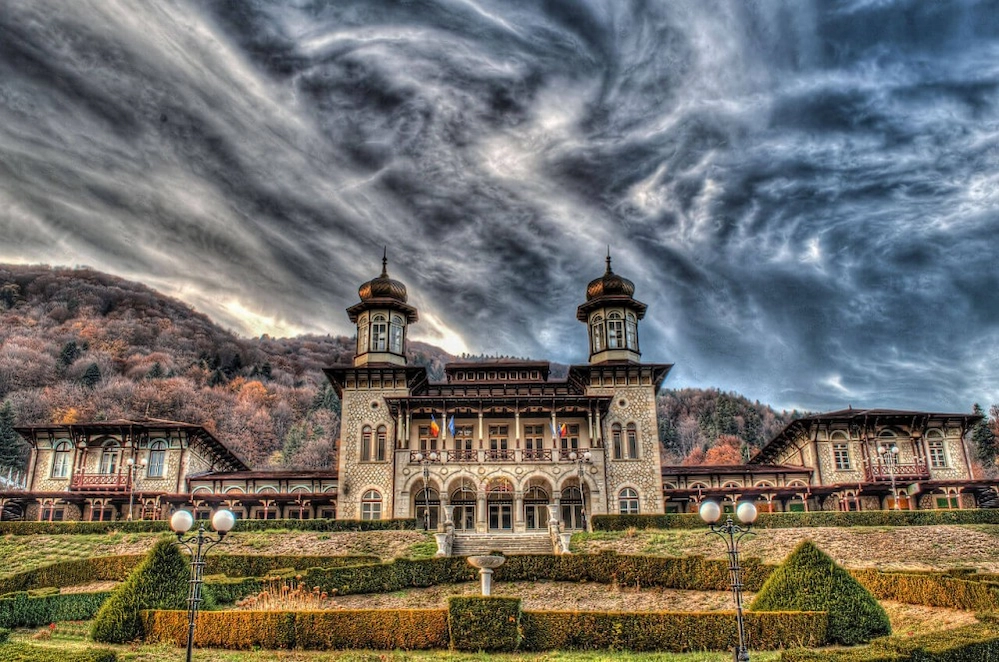
Slanic Moldova Casino
5. Bihor - Bear's Cave in the Apuseni Mountains
Explore the wonders of Romania tourism at Bear's Cave, Bihor - one of the most well-known caves in Romania today! Discovered accidentally in 1975 by a local, this cave in the Apuseni Mountains is a popular Romania tourist place. The name itself hints at its fascinating past - the cave boasts numerous cave bear fossils throughout its galleries, including an impressive intact skeleton over 15,000 years old.

Bear skeleton in the Bears' Cave. Photo by Zátonyi Sándor
6. Bistrița-Năsăud - Rodna National Park
Located in Northern Romania, this park sprawls over 46,000 hectares, bordering the historical regions of Bucovina and Maramures. Explore a diverse haven for flora and fauna, with some species protected for their rarity. Hikers can tackle the highest peak in the Eastern Carpathians, Pietrosu Mare, reaching a staggering 2,303 metres. Beyond the peaks, delve into the wonders below - explore captivating caves like Grota Zanelor or challenge yourself with Jgheabul lui Zalion, Romania's most difficult cave passage. The glacial lakes of Lala Mare and Lala Mica add to the park's magic, making Rodna National Park one of the Romania tourist places you won't forget.

Rodna National Park
7. Botoșani - The Old Town
Located on the Northern side of Moldavia, Botosani is a city that boasts an abundant cultural life, having produced major scientific and cultural personalities such as Mihai Eminescu or Nicolae Iorga.
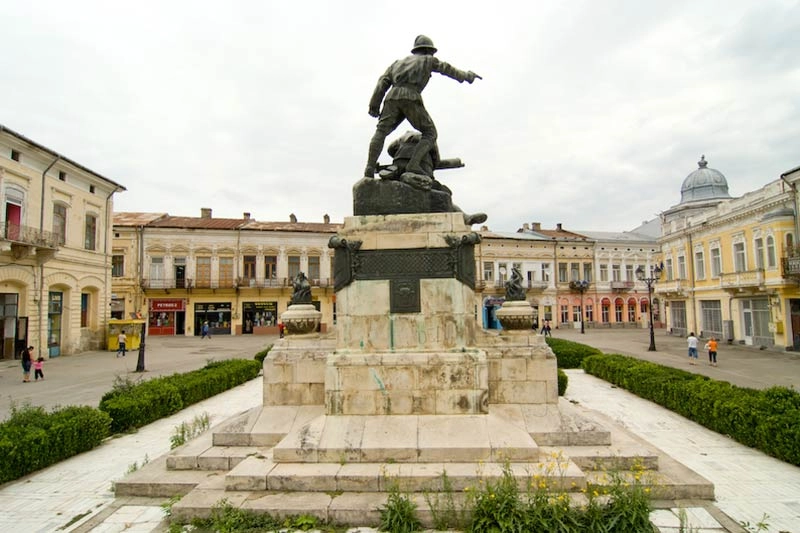
Botosani Old Town
Botosani city centre is home to 60 monument buildings that perfectly combine history with modern architecture. The area was built in the late 18th century, but a massive fire damaged many of its buildings in 1887. Nonetheless, the city centre remained one of the most stunning in Romania, and it was partially restored between 2009 and 2011.
8. Brașov - Bran Castle
No Romania tourism itinerary is complete without Bran Castle, arguably one of the country's most iconic landmarks. Built-in 1377 by Transylvanian Saxons, this imposing mediaeval castle is now widely known for its association with Bram Stoker's Dracula. Step back in time and explore the fascinating history, or visit during Halloween and experience what might be the world's biggest celebration of all things spooky!

Bran Castle
But Bran Castle is just the beginning of your Brasov adventure! This beautifully preserved ancient city is a Romania tourist place in itself. Wander the charming streets, maybe even the narrowest in Romania - Strada Sforii.
*For history buffs, don't miss Rasnov Fortress, one of the best-preserved mediaeval fortifications in the region. And nature lovers can find their fix at Poiana Brașov, a popular winter sports destination with stunning scenery year-round. Brasov offers something for everyone, making it a must-visit on your Romania travels!
9. Brăila - Maria Filotti Theatre
Originally built as an inn in the 1840s, this historic building underwent a dramatic transformation. A fire in 1859 led to its reconstruction, and by 1864, the Rally Theatre (as it was then known) rose anew. Throughout the 19th century, its stage welcomed esteemed performers from across Europe. Today, the Maria Filotti Theatre continues to be a vibrant cultural hub in Brăila. Add this unique place to your Romania tourism itinerary and experience the magic of live theatre!

Maria Filotti Theatre
10. Bucharest - Palace of the Parliament
This colossal building has a height of 84 metres and an area of 365,000 square metres, making it one of the largest buildings in the world. The Palace of the Parliament is so massive that it sinks by 6 mm each year.

Palace of the Parliament
The Palace was built as a part of Nicolae Ceausescu's restoration project for Bucharest, and today it is home to the Romanian Parliament and three museums, being composed of 23 sections. Not far is the Bucharest old town that is concentrated in the historic centre and the place included in any Bucharest tour.
11. Buzău - Berca Mud Volcanoes

Mud Volcanoes
Located less than one hour away from Bucharest, the Mud Volcanoes are by far the most famous attraction in Buzau County. Wandering around the area makes you feel like you reached another planet, but be wary - the land is very slippery, and you wouldn't want to find yourself covered in mud. The Mud Volcanoes are a must-visit on your Romania tourist places itinerary for a truly unique experience.
12. Caraș Severin - Iron Gates Natural Park
The Iron Gates Natural Park is the largest natural park in Romania, stretching over an area of 115,655 hectares. It includes part of the Danube River and of the Iron Gates gorge, which forms the boundary between Serbia and Romania.
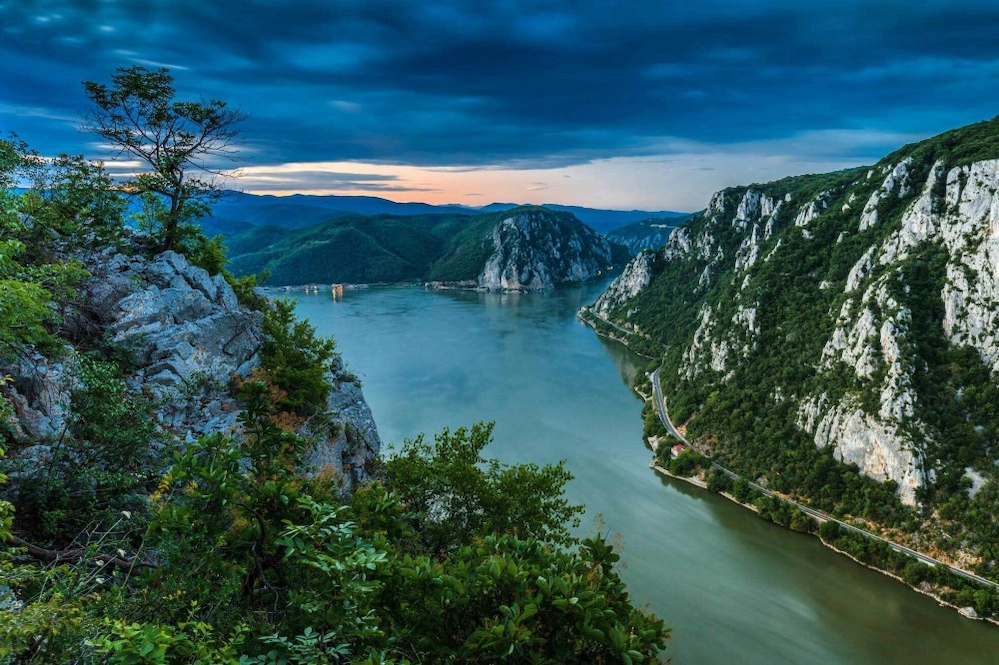
Cazanele Dunarii
This stunning park is the perfect destination for a weekend hike. You can wander around its thick forests, admire its natural landscapes, and even visit the rock sculpture of Decebalus, the last king of Dacia.
13. Călărași - History Museum of Silistra
The History Museum of Silistra was built between 1923 and 1924. It houses numerous unique monuments of Romanian and Bulgarian culture. There are two main exhibitions—the ethnographic and the archaeological—and it shelters over 41,000 unique items from the prehistoric, antique, and mediaeval eras.
14. Cluj - Turda Salt Mine
The Turda Salt Mine (Salina Turda) was mentioned for the first time in 1075 when the salt was mined manually using pickaxes, hammers, chisels, and steel wedges.
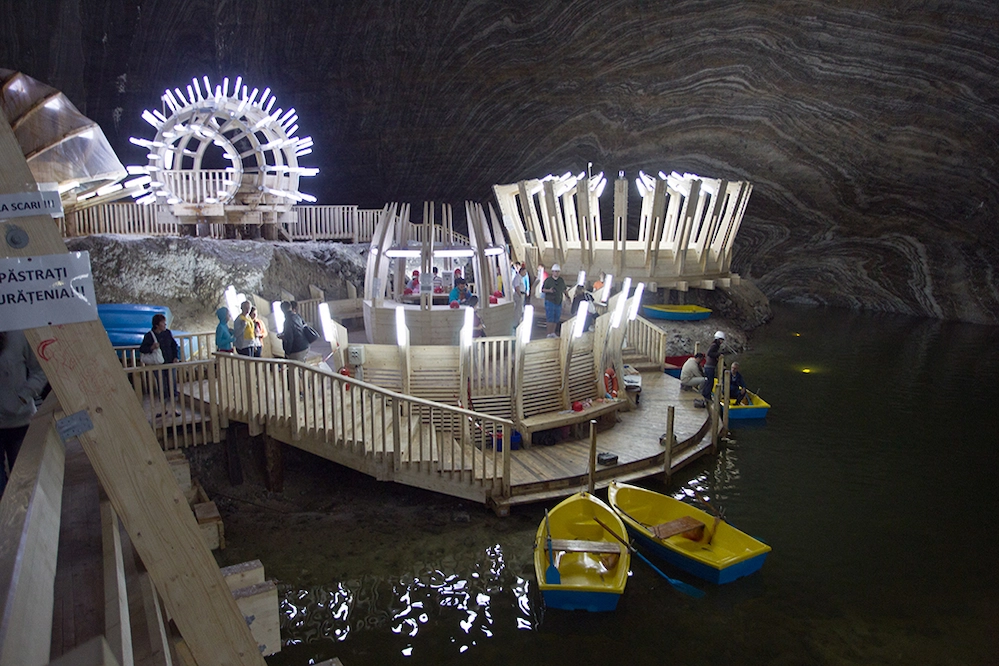
Turda Salt Mine
But those days are long gone! Today, the Turda Salt Mine has transformed into one of the coolest underground amusement parks in the world. Inside this UFO-shaped marvel, you'll find a Ferris wheel, an underground lake, a mini-golf course, and numerous ping-pong tables. It's the perfect location for a family picnic, especially during the hot summer days, making it a truly unique stop on your Romania tourism adventure.
15. Constanța - Romanian Black Sea resorts
Stretching from the Danube Delta down to the Bulgarian Black Sea Coast, the Romanian Black Sea resorts cover approximately 275 kilometres of coastline.
The most popular resort from the Romanian seaside is by far Mamaia, which is famous both amongst Romanians and tourists alike. In total, there are 12 resorts, but we recommend visiting Neptun or Saturn for a fantastic family holiday.
And if you're looking for a destination filled with youth and energy, you can't go wrong with Costinesti or Vama Veche.

Vama Veche
16. Covasna - Balvanyos
This spa resort is one of the numerous hydrothermal and volcanic features in the area, and it is located only 10 kilometres away from Lake Sfânta Ana. Even though at first glance, it might seem abandoned, the resort is a destination that promises peace and relaxation. The area is filled with countless trekking routes.
Additionally, there are at least three stunning caves waiting to be discovered nearby. This spa resort promises a unique blend of relaxation and adventure, making it a memorable stop on your Romania tourism itinerary.

Balvanyos Resort
17. Dâmbovița - The Princely Court in Târgoviște
Târgoviște served as the princely residence between 1396 and 1714, and during that period, it was the most important economic, political, military, artistic, and cultural centre in Wallachia.

Targoviste Royal Court
The Princely Court was moved to Târgoviște during the reign of Vlad Țepeș, also known as Vlad the Impaler, and visiting it will help you discover some of the legends and stories of the infamous voivode.
18. Dolj - Nicolae Romanescu Park
On your Romanian journey, be sure to explore the enchanting Nicolae Romanescu Park in Dolj, a must-see among Romania tourist places. Built between 1901 and 1903, this sprawling park offers a delightful escape for a relaxing afternoon.
Moreover, the park features a suspended bridge, a castle, a hippodrome, a lake, and one of the oldest zoos in Romania.

Nicolae Romanescu Park
19. Galați - Danube Seafront
The Danube Seafront is one of the most representative areas of Galati, and it is a great place to enjoy a relaxing walk, especially during autumn.
The whole area is oftentimes considered an open-air museum, with numerous pieces of art being placed between the alleys. The Danube Seafront is also the perfect place to have a cold beer and a fish meal near the Danube River.

Danube Seafront in Galati
20. Giurgiu - Taraf de Haidouks
While exploring Romania tourism, be sure to immerse yourself in the rich cultural heritage of the country. Taraf de Haidouks, a renowned Romani-Romanian musical group from Giurgiu, are a perfect entry point.
Formed in 1991, Taraf de Haidouks are lăutari, which translates to traditional musicians. Their captivating music blends the beautiful sounds of violins, double drums, accordions, flutes, and even wind instruments. Their talent has garnered international acclaim, even capturing the heart of Hollywood superstar Johnny Depp, who considers himself a devoted fan.

Taraf de Haidouks
21. Gorj - Parâng Mountains
The Parâng Mountains are the second-largest mountains in the Romanian Carpathians, with the highest peak reaching 2,519 metres (Parângu Mare).
They are an excellent destination for hiking and trekking, and the abundant flora and fauna can help you create some fantastic memories in the wilderness. We recommend you to arrive in Targu Jiu first, where you can admire the open-air art pieces designed by Constantin Brancusi.
22. Harghita - Lake Sfânta Ana
Lake Sfânta Ana is the only Crater Lake in Romania, and it is located inside the volcanic crater of Ciomatu Mare.
The oxygen concentration around the lake is deficient, which makes it impossible for animals to survive around it, and swimming in the lake is prohibited except for sporting events. Despite these aspects, Lake Sfânta Ana remains a captivating landmark on your Romania tourism adventure, offering a glimpse into the country's unique geological history and a truly unforgettable natural wonder.

Santa Ana Lake
23. Hunedoara - Corvin Castle
Located in the Hunedoara county, The Corvin Castle is the largest mediaeval castle in Romania. It was constructed during the 15th century at the order of John Hunyadi, the King of Hungary. This beautiful castle is split into three large areas, and it was initially designed as a defence fortress and a prison.
One legend claims that this is the place where Vlad the Impaler was imprisoned for several years, although there is no official source to support it.

Corvin Castle
Not far from Corvin castle are Sarmizegetusa Regia and Ulpia Trajana, the historical landmarks representative for the historic sites and the ancient ruins of the capital of the Dacian Kingdom.
24. Ialomița - Lake Amara
Lake Amara is a protected area which houses numerous important bird species, and it is widely renowned for its sapropelic mud and its therapeutic waters.
Lake Amara boasts sapropelic mud, rich in organic materials, and mineral-rich waters renowned for their therapeutic benefits. While swimming in the lake might not be for everyone, exploring this protected area offers a chance to witness a variety of birdlife and delve into the natural wonders Romania tourism has to offer.
25. Iași - Palace of Culture
Known as "The Cultural Capital of Romania," Iasi is the second-largest city in Romania, after Bucharest, and travel experts consider it one of the most beautiful Romanian cities.
It is a true symbol of Romanian history, and here you will find the oldest Romanian university and the first Romanian engineering school. The city features historical monuments, churches, and monasteries that are more than 500 years old, as well as modern buildings that feature contemporary architecture.
The landmark of the city is by far the Palace of Culture, which houses the Moldavia National Museum Complex and the Cultural Heritage Conservation-Restoration Center.
Its construction started in 1906, and its architecture includes numerous representations of the gothic bestiary, such as two-headed eagles, dragons, griffons, and lions. The Palace of Culture has a total of 298 rooms; it features a Clock Tower with a beautiful legend. This iconic monument was inaugurated in 1925, and it is the highest expression of Neo-gothic architecture. The building features 298 rooms, and it is home to four museums, with countless historical artefacts and several art galleries.
Besides the Palace of Culture, Iasi has numerous other landmarks that can make for an amazing experience, such as the Botanical Garden, the "Vasile Alecsandri" National Theatre, and the "Gheorghe Asachi" Technical University Library.
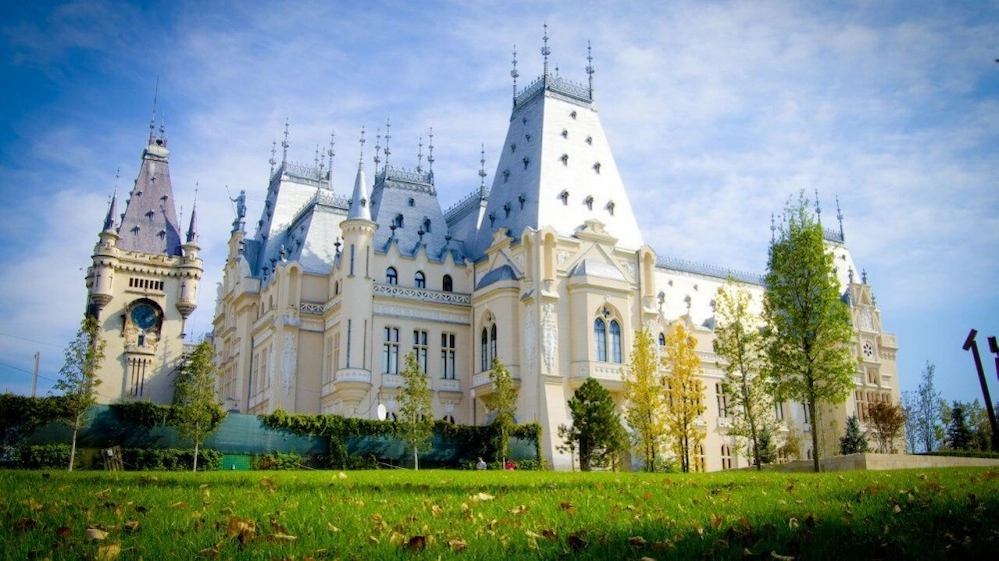
Palace of Culture
26. Ilfov - Mogoșoaia Palace
When you visit Mogosoaia Palace as part of your tour of Romania tourist places, you can fully immerse yourself in the country's rich architectural legacy and history. Constructed between 1698 and 1702 by Constantin Brâncoveanu, this magnificent mansion epitomises the Brâncovenesc style and is located just 10 kilometres from Bucharest.
Beyond the stunning architecture of the palace, the adjacent gardens provide a serene refuge. Wander around the lovely grounds, which are ideal for unwinding or practising meditation. A fascinating combination of history, pleasure, and the great outdoors may be had during your visit to Mogosoaia Palace with the addition of horseback riding instruction for a very unique experience.
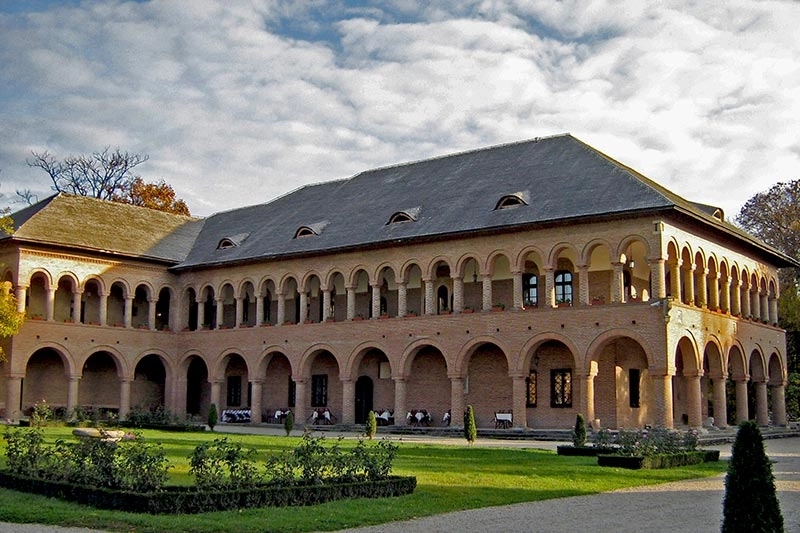
Mogoșoaia Palace
27. Maramureș - The Merry Cemetery
The Merry Cemetery, which is situated in Săpânţa village, is well-known for its brightly coloured tombstones and humorous epitaphs that summarise the life of the deceased.
Local artist Stan Ioan Pătraş created the cemetery and carved the first tombstone crosses, including the first epitaph, which was engraved in 1935.
This location is thought to have Dacian roots, primarily because in Dacian tradition, passing away was viewed as a happy occasion since the deceased's soul would have an improved and immortal life.

Merry Cemetery
28. Mehedinți - The ruins of Trajan's Bridge
Trajan's Bridge, or the Bridge of Apollodorus over the Danube, was one of the greatest achievements of Roman architecture. Despite being functional for only a few decades, the bridge was built before the Second Dacian War to allow Roman troops to cross the Danube River.

The ruins of Trajan's Bridge
After conquering Dacia, the wooden structure of the bridge was dismantled by Hadrian, but the remains of the bridge can still be seen to this day.
29. Mureș - Sighișoara Citadel
Steeped in history and charm, Sighișoara Citadel in Mureș County is a must-see on your Romania tourist places adventure. The intriguing history of this fascinating city started in the 12th century when the German merchants and artisans were invited by the Hungarian King to settle in Transylvania and strengthen the region's defences.
On the border of Central Europe, their presence turned Sighișoara into a vibrant commercial and strategic hub. The city's economy was controlled by German artisans who left their imprint through continuous fortification efforts. According to estimations, Sighisoara had an astonishing twenty branches of handicrafts and an astounding fifteen guilds throughout the 16th and 17th centuries alone.
Sighișoara and the rest of Transylvania were included into the Kingdom of Romania after World War I. The city's colourful homes bordering cobblestone streets still attract tourists today, enhancing its standing as one of Romania's most alluring travel destinations.
Sighișoara's birthplace, Vlad the Impaler, and its well-preserved Historical Centre were both added attractions to the city in 1999 when it was named a UNESCO World Heritage Site.
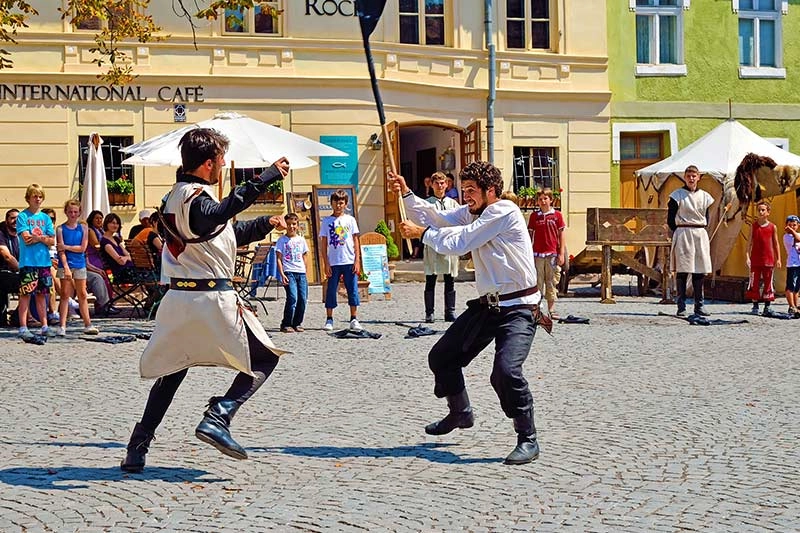
Street performers in Sighisoara
While exploring Mureș County, consider venturing beyond Sighișoara to discover the equally fascinating Târgu Mureș Medieval Fortress, another gem waiting to be explored on your Romania tourism itinerary.
30. Neamț - Vânători-Neamț Natural Park
For a delightful family escape on your Romania tourism adventure, look no further than Vânători-Neamț Natural Park. The natural reservation is filled with wildlife such as deer, pheasants, and peacocks, but the highlight of the park is, by far, the European bison. Even if it is not on the tourist beaten path, the natural park is the European equivalent of Yellowstone Park.
Beyond the park's captivating wildlife, take some time to explore the breathtaking natural landscapes surrounding the city of Piatra Neamț. This enchanting area offers a perfect complement to your Vânători-Neamț Park adventure, making it a truly unforgettable experience on your Romania tourist places itinerary.
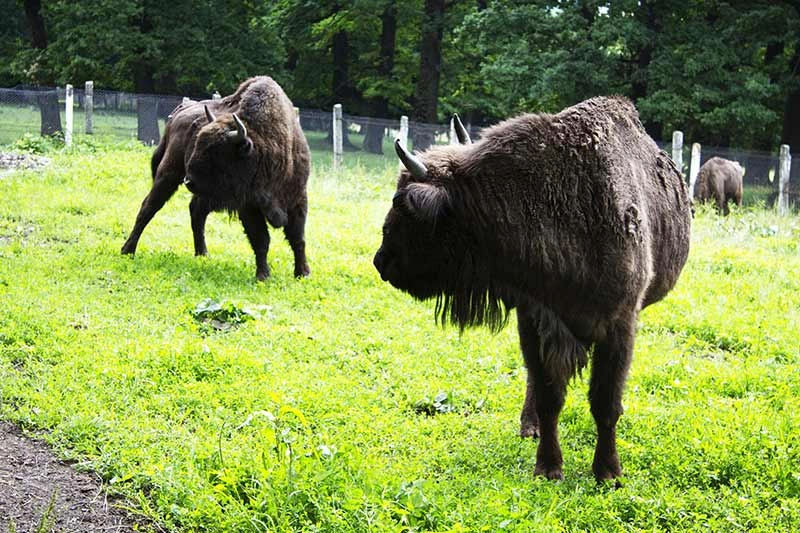
Neamt Bison Reservation
31. Olt - Constantin Poroineanu Park
The most attractive park in Olt County is Constantin Poroineanu Park, which was constructed similarly to Cișmigiu Park in Bucharest.
Spanning almost 25 hectares, the park boasts an abundance of lush vegetation, many lanes and artwork, a football stadium, a handball court, and a lake.

Constantin Poroineanu Statue
32. Prahova - Peleș Castle
Peleș Castle was constructed between 1873 and 1914 following the instructions of King Carol I, and it served as the summer residence of the Romanian Royal Family.
Currently functioning as a National Museum, the castle is exclusively accessible through guided visits. The Grand Armoury, which holds 1,600 of the 4,000 pieces of armour and weapons, The Imperial Suite, The Turkish Parlour, and The Moorish Room are a few of the most impressive chambers.

Peles Castle
33. Satu Mare - Țara Oașului
Stepping back in time on your Romania tourist places adventure, explore the captivating region of Țara Oașului. Renowned for its meticulously preserved traditions spanning centuries, Țara Oașului is considered one of Romania's oldest inhabited regions.
Negrești, the area's largest city, serves as the perfect starting point for your exploration. Here, delve into the fascinating world of Țara Oașului at the Țara Oașului Museum. This treasure trove boasts hundreds of exhibits showcasing traditional clothing, ceramics, everyday household objects, and intricate woodworking, offering a glimpse into the region's rich heritage and enduring way of life.
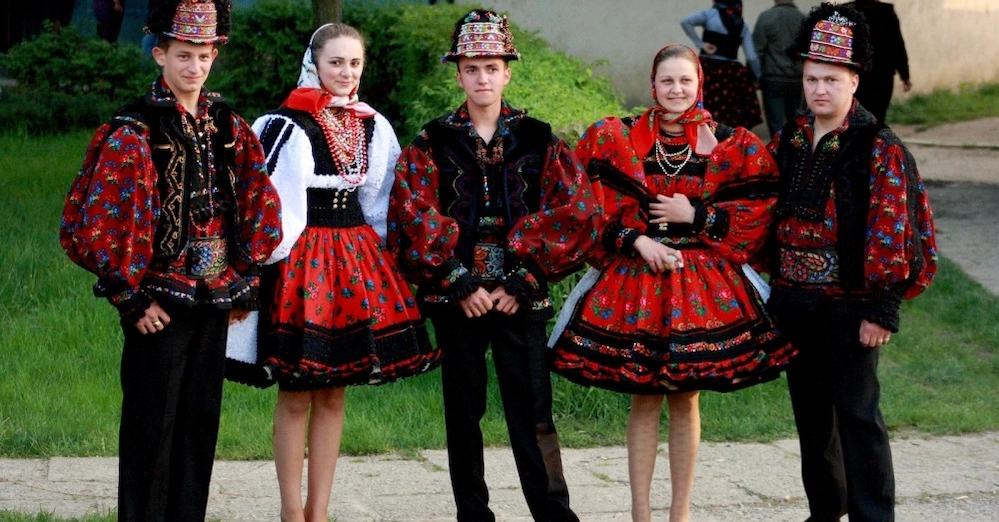
Locals in Tara Oasului
34. Sălaj - Vasile Fati Botanical Garden
The botanical garden was founded in 1968 by Professor Vasile Fati, and it became the foundation of the study of biology. The garden is organised in several sectors, such as a research centre, a zoo, a Japanese garden, and an aquarium.
Whether you're a passionate botanist or simply seeking a peaceful escape, the Vasile Fati Botanical Garden promises a delightful experience for visitors of all ages on your Romania tourism itinerary.

Vasile Fati Botanical Garden
35. Sibiu - Biertan Fortified Church
Founded in the fifteenth century by the Saxons residing in Transylvania, Biertan and its neighbouring village are included in the UNESCO monument known as the Transylvanian Villages with Fortified Churches.
The church is defended by multiple defence towers and features three rows of external defences connected by gate towers.
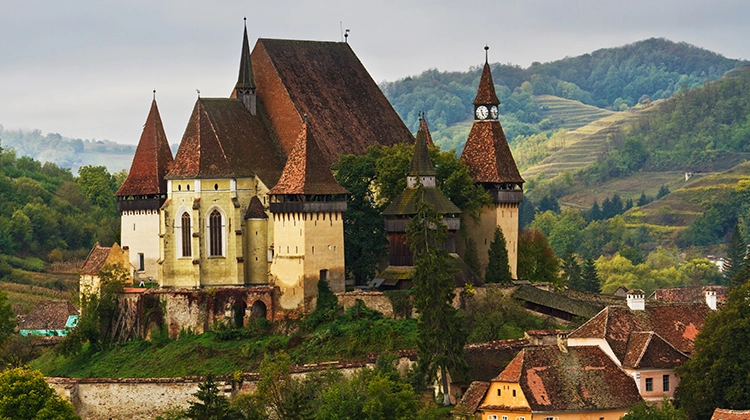
Biertan Fortified Church
*Take your time and explore Sibiu as well. Sibiu is a gastronomic region in Europe with stunning architecture in addition to some incredible food.
36. Suceava - The UNESCO Painted Monasteries of Bucovina
Unveiling Romania's cultural treasures on your Romania tourist places adventure, be sure to include the captivating Painted Churches of Bucovina on your itinerary. These eight magnificent structures designated a UNESCO World Heritage Site in 1993, were constructed between 1487 and 1583.
The story behind these masterpieces begins with Stephen the Great, a visionary ruler who commissioned the construction of roughly 40 churches throughout his reign, many celebrating victories against the Ottoman Empire. While Stephen initiated this grand project, it was his son, Petru Rareș, who had the brilliant idea of adorning them with frescoes.
The resulting Painted Monasteries of Bucovina are considered true gems of Byzantine art and hold a central place in Romanian Orthodox life. Among these, the Monastery of Voronet reigns supreme in its beauty.
Often dubbed the "Sistine Chapel of the East," Voronet Monastery was established in 1488 by Stephen the Great. Remarkably, it was constructed in a mere three months and three weeks to commemorate the triumph at the Battle of Vaslui. One of Voronet's most captivating features is its unique shade of blue used in the murals. This "Voronet blue" has become legendary, its exact composition a lost secret that continues to baffle experts.
While Voronet may be the most renowned, each monastery offers its own unique treasures. For instance, the Moldovița Monastery boasts exceptionally well-preserved exterior frescoes, particularly those on the south wall depicting the Siege of Constantinople.
The Painted Churches of Bucovina offer a captivating glimpse into Romania's artistic heritage, religious history, and enduring cultural identity.

Sucevita Monastery
37. Teleorman - Troianu Forest Natural Reservation
Venture into a haven of natural beauty on your Romania tourist places adventure with the enchanting Troianu Forest. One of the last surviving sanctuaries in the area, this priceless natural feature is tucked away in southern Romania.
Troianu Forest, which covers an area of more than 71 hectares, is home to rare wildlife and beautiful beauty. The Romanian peony, an exquisite and endangered flower that thrives in the embrace of the forest, is the main draw here. Seeing these vivid blooms in their native environment is an experience that will never be forgotten.

Romanian Peonies
The woodland is known for its magnificent oak trees, which enhance the allure of this peaceful haven beyond the flowers. Several beautiful walking trails have been meticulously planned by the committed local government, enabling guests to discover the forest's hidden gems at their own leisure.
Enjoy the Romanian tourism!
Romania tourism offers a captivating tapestry of experiences woven from breathtaking natural wonders, rich historical sites, and vibrant cultural traditions. This guide has unveiled just a glimpse of the many Romanian tourist places waiting to be explored, from each country's unique gems to unforgettable adventures across the country. Whether you seek historical immersion, outdoor thrills, or a taste of local charm, Romania has something for everyone.
So, start planning your Romanian adventure today and discover the magic for yourself!